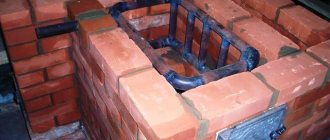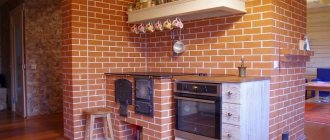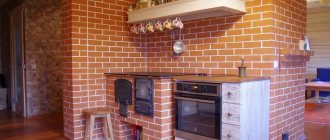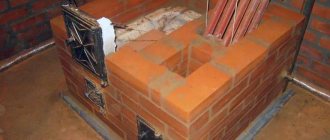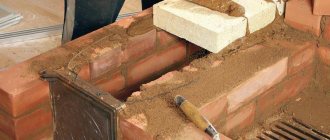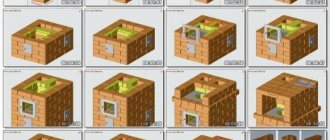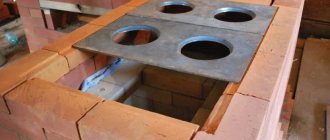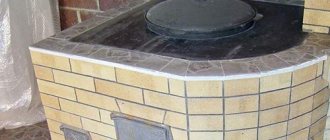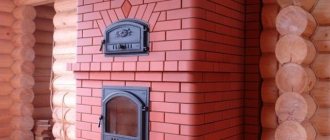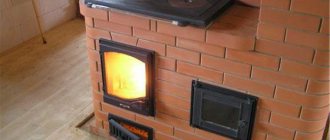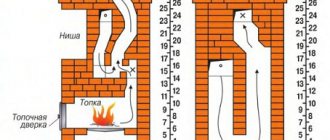To heat a large house consisting of several rooms, you should choose the most economical option, for example, a stove with a boiler. A modern brick stove with a water circuit makes it possible to heat all rooms from one point. The coolant in it is able to distribute heat evenly and maintain the desired temperature over the entire area. Before purchasing such a unit, it is necessary to study in detail the principle of its operation, all the pros and cons, as well as the connection method and type of system.
How to choose a project? Order
First of all, decide on the conditions in which the furnace with a water circuit will operate.
If this is integration into an existing OS, it is important to ensure interchangeability in the operation of existing communications. For the independent option, it is important to determine the area that the system will heat
For 100 square meters of a one-story house, a conventional stove is quite enough.
Another thing is if the area, number of rooms and floors is larger
Finally, it is important to understand whether the OS will be used all year round or only in cold weather. If people live in a house in the summer, and in winter it is idle, then after cold weather and frosts the system will require restoration work, which will entail additional costs
Photo 4. An example of the order of a brick kiln with a water circuit: the initial stages of construction from 1 to 20 are depicted.
What materials will be needed
For the furnace itself: concrete, mortar, refractory and red clay bricks, valves, fire door, grate, ash pan.
For the manufacture of a heat exchanger: metal pipes with a diameter of up to 50 mm or steel sheets 3 mm thick and a rectangular profile 60x40 mm.
For the manufacture of outlet and supply lines of the furnace: metal pipes. For distribution of hot water throughout the house: polypropylene pipes and radiators.
Required Tools
For laying the furnace, making a heat exchanger, installing communications and heating devices you will need:
- building level;
- roulette;
- Master OK;
- bucket;
- pliers;
- electric drill;
- welding inverter;
- wrench;
- screwdriver.
Other tools may also be required, since the laying of a furnace with a water circuit and the wiring in each case are carried out taking into account individual conditions.
Preparing the site
A furnace with a water circuit is located in a fireproof area that is waterproofed.
This area of the room should be well ventilated and access to the oven should always be open. Then make sure that the place for the stove is level and its walls rise up at a right angle.
It is important that the roof allows the pipe to be brought outside without obstacles. Then check how strong the foundation under the future structure is
After all, a stove is a heavy structure that requires a prepared base. The approximate weight of the stove is calculated by equating 1 cubic meter to 1350 kg. If a suitable location is identified, it is cleared and prepared for the construction process.
Attention! To achieve maximum effect, a stove with a water circuit is positioned so that it heats as much space as possible. This will reduce heat loss and reduce the cost of its production.
Building a stove with a water heating boiler with your own hands
Construction begins with the foundation. Its lower part is filled with concrete, and its upper part is laid out with bricks. Then the laying begins. The first row is laid out dry, and then - on the solution. In this case, the masonry is made from the walls to the middle.
During the laying process, a heat exchanger is installed in the firebox, and the pipes coming from it are distributed throughout the body right up to the point of entry/exit of communications. When external communications are installed, water is released into the circuit and the system is tested for leaks. If the test is successful, the furnace with a water circuit is considered ready for operation.
Difficulties during construction and commissioning
The main challenge when building hot water furnaces is their integration into the existing building layout. You have to look for a convenient place in it, and then adapt it to the operating conditions of the furnace.
If you put the design of the system into perspective at the design stage of the building, you will be able to calculate all the nuances and make the efficiency of the heating system as high as possible.
It is better to test the elements of the water circuit (heat exchanger, pipes for hot water outlet and return inlet) immediately after manufacture and before installation.
If everything is already built and installed, and the heat exchanger suddenly leaks, you will have to dismantle the masonry and disconnect the communications in order to eliminate the detected defect.
Another problem when building a system can arise from pressure. The liquid moves through the water circuit under its own pressure. But it is not always enough for the coolant to reach remote areas of the room. Then an electric pump comes to the rescue to distribute heat evenly throughout all areas of the building.
The correct procedure for installing stove heating with water circuits
The dimensions of furnaces and their location are usually reflected in the design stages.
In this case, the location of interior partitions and furniture must be taken into account. Large ovens require a strong concrete base that can support the weight. There should be a gap between the base of the stove and the floor material to reduce the likelihood of fires. Masonry is done using high-quality mortar and bricks. If you have no experience, it is better to purchase the mixture from construction organizations. A waterproofing layer must be laid on the base. The bricks are soaked in water and only after that are used for laying out according to the pattern. Once the dimensions are known, the order can be easily found on the Internet.
A register-coil is installed into the structure being built, which is then used to connect the coolant input and output pipes. According to one of them, the hot coolant is sent through the expansion tank into the system, and according to the other, it returns back to the register. Water circulation occurs due to the presence of gravitational forces.
Seams should not exceed four millimeters. The presence of sharp corners in the firebox and smoke exhaust ducts is not allowed. Rounded corners will not reduce smooth smoke removal, and there will be less soot in the firebox.
Important rules for constructing furnaces
Regulatory requirements for the construction and operation of the furnaces in question are as follows:
- It is mandatory to have a gap between the stove and the adjacent walls and a metal sheet in front of the firebox, which serves to protect the floor and wall structures.
- Ensuring maximum strength by reinforcing every four rows of masonry with metal pins.
- Using clay mortar of medium plasticity. A small ball rolled out of it does not give large cracks and does not crumble when it hits the floor.
- The chimney, at least five meters high, ends with a cap, that is, an element that protects the pipes from rain and debris getting inside. It enhances traction and decorates the building.
It’s not that difficult to build a stove yourself, although it may be possible to use a ready-made metal structure. However, you should not forget that a brick stove has a more aesthetic appearance, decorating the interior of homes.
It is necessary to choose a suitable brick, the best option of which is red ceramic, pre-fired. It has a uniform color. When tapped, a metallic sound is heard.
Burnt and unburned material cannot be used, since it will not guarantee the required quality and compliance with safe operation standards. For fireboxes where the highest temperatures are observed, the best option would be to use refractory refractory bricks, which will eliminate problems during the operation of this equipment.
Water circuit installation
A water heating system works efficiently by installing a register, which is a heat exchanger or boiler. Its popular name is serpentine. This product is placed in the firebox.
The design of such a system includes combustion chambers, ash pans, hermetic doors, cleaning hatches, heating surfaces, injectors, dampers, grate bars and convective pipes.
When making containers yourself, the parts are connected only by welding. Couplings, fittings, etc. are used to connect pipes. This design guarantees savings on the boiler, since the materials for it are cheaper than what is needed to purchase a finished unit. The best option is to use a regular metal pipe with holes for the inlets and outlets of the pipelines.
The construction of a heat exchanger for a home requires a certain thickness of structural walls. If you plan to use a wood-burning stove, the walls may be thinner, while those operating on coal briquettes may be thicker. Ignoring this requirement leads to rapid burnout of boilers and their rapid replacement, ahead of the established operational dates. In practice, this means that you will have to actually reassemble the stove after such a replacement, investing additional funds.
Which stove to choose
Each type of furnace-boiler is appropriate for solving certain problems.
When heating utility rooms or greenhouses, there is no need to fence a multi-ton colossus of bricks. Most consumers in this case choose the simplest boiler.
Photo 1. The process of building a heating furnace with a boiler. A heat exchanger made of pipes is mounted in the firebox.
If the house already has a working brick Dutch oven, you can insert a heat exchanger welded from pipes or sheets of metal into its firebox. To do this, you will have to remove the door, expand the opening of the fuel chamber, insert the heat exchanger and put everything back in place.
When constructing a new furnace, the Kuznetsov boiler design is considered optimal. High heating efficiency is achieved by installing a heat exchanger in a hot hood, where the temperature is higher. The wood in the firebox of the stove burns in an optimal mode, and the hot gases heat the stove hood with a heat exchanger. The temperature rises gradually and remains stable for a long time without additional heating.
Design
There are many types of heating brick stoves. They can perform only the function of heating the room or combine heating and cooking. There are also combination stoves with several fireboxes.
The principle of operation of a brick oven, regardless of its design, is the rapid accumulation of heat during combustion and its long-term release by the walls of the oven for several hours or even days. The stove material is ceramic brick, a good heat accumulator.
To increase the volume of heated brick, the smoke channels in the furnace are made extended, placing them along the walls. Hot smoke, passing through them, heats the brick and by the time it leaves the chimney it has a safe temperature. In addition to increasing efficiency, this design feature of brick kilns reduces the risk of overheating and roof fires.
Laying a heating and cooking stove
Before work, it is necessary to make a drawing of the furnace and a detailed order plan. You can use ready-made schematic solutions. The Kuznetsov stove with a radiator hidden in the chimney duct on the side of the stove is popular.
Kuznetsov furnace
Kuznetsov furnace:
Construction materials
To create a brick kiln, prepare:
- concrete;
- solution;
- fireproof fireclay, red brick;
- valves;
- firebox door;
- grate;
- ash pit.
For the heat exchanger you will need:
metal pipeline with a cross-section of up to 5 cm, sheet steel 3 mm thick.
Outlet and inlet communication lines are made of metal pipelines. The water circuit lines for supplying hot water throughout the house are made of polypropylene pipes and batteries.
Diagram, dimensions of the furnace unit
Technical parameters of the heating unit:
- length/width/height - 102x116x238cm;
- heat exchanger dimensions - 75x50x35 cm;
- battery power - 6 kW. You will have to add fuel twice a day. You can heat 60 sq. m at home.
FurnaceExternal cross-section of the furnace
Step-by-step instructions for laying a stove
Detailed instructions for installing a brick kiln:
- The furnace is being marked. The foundation is poured 50 mm below the future final floor covering. To increase reliability, it is worth performing reinforcement with rods. It is necessary to exclude contact between the stove foundation and the foundation of the house.
- Once the foundation is completely dry. He'll be ready. You can start laying bricks according to the order scheme. The first two balls are made of red solid material on a cement mixture. The purpose of the masonry is to level out the resulting unevenness in the foundation. The foundation is being laid.
Foundation
The layers are connected using clay mortar.
- The thickness of seam joints between individual rows should not exceed 5 mm. The smaller, the more uniform the surface of the structure will be. Heat dissipation is better.
- The jointing is carried out immediately after laying the brick.
Masonry
- Arrangement of the door to the furnace: before installing the door on the brick, an asbestos plane is laid. An annealed wire 0.4 m long is located in the corners of the frame. Fastening is carried out between brick rows. The circuit will make the door more reliable, otherwise the solution will crumble. It will fall out of the oven. You need to check the location of the door with a building level. An asbestos strip is placed on top.
- The firebox is lined with fireclay refractory bricks. A simple brick will crack and fall apart. The schematic representation of fireclay building material in the sketches is done in yellow.
- If you need to install a hob, grooves are left under the stove. Heat losses are minimized. Smoke is prevented. The tiles are laid using mortar.
- A self-created heat exchanger is placed in the chimney at the stage of laying the brick layer, which is equipped with a lower fitting. It is installed in the combustion chamber when the last firebox ball is being laid. The distance between the heat exchanger and the brickwork should be within 5-6 mm.
- Cleanout doors are installed in the chimney. They remove accumulated soot, otherwise heating will deteriorate. There should be enough doors to provide access to every section of the chimney duct.
- A damper or damper is made at the top of the chimney. The chimney structure can be made of brick, the same as the stove. You can purchase ready-made sandwich panels. It is necessary to follow the rules for contact between the pipeline and the roof. The brick chimney is made with a plow.
Stove heating has been used for many centuries. Heating systems have been improved. To heat the house evenly, a water circuit with radiators is used. You can make heating for a private home on your own. The main thing is to follow the instructions.
Manufacturing a brick kiln with a water heating system:
average rating
more than 0 ratings
Share link
Preparatory activities
Organizing stove heating involves preparing drawings, choosing a suitable location for pipes and radiators, as well as competent calculation of power. Next, a register is made or purchased and the structure with a built-in heat exchanger is laid.
Calculation of power and dimensions
The efficiency of a heat exchanger is determined by the materials from which it is made. Cast iron products of the MS-110-300 and MS90-300 series have a power of 0.14–0.16 kW/sq. m for the rib. Taking into account such figures, it is possible to predict the number of sections for heating each circuit. For 10 sq. m of area you need at least 1 kW. For a building of 60 sq. m. requires a register with a power of 5.5 kW.
The efficiency of a heat exchanger is affected by the materials from which it is made.
The dimensions of the furnace system are 1020x1160x2380 mm. The heat exchanger has dimensions of 750x500x350 mm.
Required materials and tools
To assemble the stove you need to prepare:
- A sufficient amount of fireclay and solid bricks with fire-resistant properties.
- Furnace and blower doors.
- Grate.
- Steel corners and strips.
- Valves for ovens and cooking chambers.
- Pre-furnace sheet.
The tools you will need are a basic stove set and containers for mixing the solution.
Boiler installation
When implementing plans to create a combined heating system, it is important to pay attention to some features. Water-heated brick stoves have many options, each of which differs in material, type of main element and other nuances. Ignoring technical and construction requirements will certainly lead to the rejection of the entire work
Ignoring technical and construction requirements will certainly lead to the rejection of the entire work
Ignoring technical and construction requirements will certainly lead to the rejection of the entire work.
The boiler must fit completely into the firebox. However, in practice there are incidental situations when part of the heat exchanger is located outside the stove. This is unacceptable, because the main task of the unit is to heat the coolant. The boiler is made in the shape of a “P” from pipes or sheet iron. All its elements are hollow and are designed to remove heat.
The preferred option is from pipes. It has a larger convection area and allows the flame to reach the cooking surface to cook food. In addition, attention is required:
Dimensions. It would seem that a massive product is needed that can heat a lot of water and provide heat to a decent-sized structure. But that's not true. The boiler itself is made of very modest dimensions - 75 * 50 * 30 cm (length, width, height). The convection surface of such a device is enough to heat a house up to 200 square meters. Installing a pump for forced circulation of coolant increases productivity by up to 50%. Boiler. Its shape is designed in such a way that the heated surface area is as large as possible
It is very important to install it in the center of the combustion center. This is the only way to achieve high efficiency of water heating. Peculiarities. It is necessary to leave a small gap between the walls of the furnace and the surface of the boiler
The optimal distance is considered to be 5 millimeters. It is quite sufficient to level the free movement of the metal during thermal expansion.
A small gap must be left between the walls of the furnace and the surface of the boiler. The optimal distance is considered to be 5 millimeters. It is quite sufficient to level the free movement of the metal during thermal expansion.
The heat supply and outlet lines are carried out in strict accordance with the laws of physics. It is known from school that hot flows tend to go upward, while cold flows are always directed downward. Therefore, the pipe supplying hot water to the house is always adjacent to the boiler at the top point, and the channel with the “return” is at the lowest point. This arrangement eliminates the accumulation of hot steam, which poses a serious threat to the integrity of the system.
A more complex water heating system using wood
It is a pyrolysis boiler. which consists of two sections. In the lower section, firewood is burned, and in its upper part, the gas generated during combustion circulates. Due to the fact that in this design, gases do not immediately enter the chimney, its efficiency is higher, and such a boiler consumes less firewood.
It is tied with thick-walled pipes through which water circulates, heated by the boiler.
It is necessary to take into account that for the normal functioning of such a boiler, it is necessary to use only dry firewood. If the farm has a pyrolysis boiler, then there should also be a supply of well-dried firewood.
There are systems that use hot air rather than water for heating. It passes along the circuit and is supplied to the living quarters. Cooled air, according to the physical law of convection, falls down, enters special air intakes and again enters the boiler.
Safety regulations
The main rule is not to close the oven view ahead of time. Kuznetsov’s boiler works on the principle of a gas view - cold gases do not mix with hot ones, so the stove does not cool down much. If you close the view ahead of time, carbon monoxide may enter the room, causing poisoning.
The boiler is especially afraid of overheating - the boiling coolant will rupture the heat exchanger. Therefore, in severe frosts, if the power is not enough, resort to additional heating of the room with electric heaters.
When installing a water pump in the heating system, operating efficiency increases.
When firing, some parts of the stove become very hot. Keep small children away from doors and do not let teenagers heat the house.
While burning, keep the door either closed or slightly open, as escaping embers can cause a fire.
An “apron” made of ceramic tiles or a sheet of iron is installed in front of the stove.
Soot is removed twice during the heating season. Its accumulation in the chimney can lead to a fire.
A brick stove is an excellent option for heating a home. The rules for safe use are simple and intuitive.
Additional electric heating of the system
Stoves with a heating circuit are often installed in a country house or in a private country house, and are not used for constant heating. In this case, in cold weather the system may freeze, which will lead to ruptures and water leakage during the first fire.
In this case, instead of water, you can pour antifreeze into the system or additionally buy and install in parallel a low-power electric boiler that automatically turns on to maintain the water in the system in the range of 5-10 degrees. An electric boiler will not allow the system to freeze, and their price is not too high, and with a certain skill you can make homemade electric boilers.
Laying a stove with a heating circuit with your own hands may seem like too complicated a task, and the price for the services of specialist stove-makers is high. In this case, it is better to consider the possibility of installing a long-burning industrial boiler using wood or other fuel. But a self-built stove is not only a heating element, it is also the heart of the house, giving comfort and family peace, and if all recommendations are followed, it will last a long time and efficiently.
Advantages and disadvantages of a combined system
A stove with a traditional heater heating boiler consists of components such as grates, a smoke exhaust duct, an ash pan and a combustion chamber. These attributes of a classic country stove are familiar to any village resident. As for modern stoves, visually they are almost completely identical, but they have slightly different characteristics:
- A simple village stove emits no more than 6500 Kcal of heat per hour of operation. This amount of heat is enough to heat a house with a small area. This heating method is ideal for a country house.
- If stove heating is combined with water heating, the productivity will increase several times. It will also be possible to heat a larger area of the house. In this case, the same amount of solid fuel will be burned. In addition, not so many exhaust gases will be emitted into the atmosphere, which will increase the efficiency of the system.
- In order to achieve even higher efficiency, you can combine two heating systems, convection and water. During simultaneous operation of two systems, their performance will be summed up. In one hour of operation, such a tandem will produce up to 21,000 Kcal. This amount of heat is enough to heat a house with an area of up to 300 square meters. meters.
- An important advantage of such a heating system is the availability of fuel. Typically, wood or firewood and coal are used to operate such a heating system. This fuel is the most accessible and relatively inexpensive.
Firewood is the most affordable fuel for heating
- A stove with a water heating boiler does not require a constant fire. For such a system to function, you will need to add fuel only 2 times a day. Regardless of what the temperature is outside, it will be possible to create the most optimal microclimate for you in the house.
- The efficiency of an ordinary village stove reaches a maximum of 50%. If you combine two heating systems, this figure will increase to 85%. Taking into account the fact that a wood-burning stove is used to organize the heating system, this indicator is ideal.
Stove heating also has its disadvantages. Such a stove-boiler for heating a house can be installed not only in a country house or village house; sometimes it is installed in country houses belonging to the elite category. Sometimes such stove heating boilers can perform not only the role of a heat source, but also a decorative function.
A stove can be a wonderful home decoration
Types of systems
There are two options for heating a house using a stove. In the first case, it will be a system with a natural type of coolant circulation, and in the second - forced circulation.
Steam heating from a natural circulation stove does not require an electrical connection, since water circulates through the heating circuit due to the laws of physics. However, in this case, the heating pipeline must be of a large diameter, which leads to an increase in the volume and inertia of the system. Such a stove will take quite a long time to heat up when lit. At the same time, when the wood burns out completely, the coolant in the circuit will remain warm longer.
Among the disadvantages of natural circulation in steam heating from a stove in a private house, it is also worth mentioning the fact that the supply pipes must be placed either under the ceiling or at the level of the radiators. If the house is two-story, a pipe comes out from the top of the stove, through which the coolant disperses through the radiators of the second floor, and only then falls to the first floor and heats the rooms on it.
Do-it-yourself stove heating with a natural circulation type is not highly efficient, since the water in the circuit moves slowly and does not supply enough heat to the premises.
In the second case, a water-heated brick oven is equipped with a circulation pump, which ensures constant movement of the coolant inside the circuit at a certain speed. By changing the speed parameters, you can regulate the degree of heating of the rooms. Thus, this type of system is more efficient. However, it requires electricity to operate. If there is a power failure, the pump will turn off and the coolant inside the operating furnace will boil. To avoid such troubles, in case of sudden power outages, the circulation pump should be connected to an uninterruptible power supply with a battery. If there are regular power outages, you will also need a power generator, and this is quite expensive.
How to increase the efficiency of a solid fuel boiler, including one made by yourself
The disadvantage of all solid fuel boilers is that some of the heat is carried away into the chimney, reducing their efficiency - especially with a straight and high chimney. To reduce heat loss and increase the efficiency of solid fuel boilers, you can use the methods that I used in my home.
The first method is to use the energy of flue gases to additionally heat the room
To do this, it is necessary that the solid fuel boiler is located in the basement or on the ground floor of the house and that the height difference between the bottom of the boiler firebox and the upper cut of the chimney is large enough - at least 7 m.
To use the heat that is carried away into the chimney, a heating stove or heating panel is erected in the room or between rooms. The solid fuel boiler is positioned so that it is under the stove or shield. The design of the heating furnace is carried out in such a way that flue gases from the boiler pass through its smoke circuits. At the exit from the firebox of the stove, a valve is installed, which closes when the boiler is fired and opens when it is necessary to heat the stove, for example in the off-season, when the boiler is not yet heated or in another case.
Rice. 7
Option for the location of a solid fuel boiler (horizontal) in the house: 1 - heat exchanger; 2 - boiler body; 3 - slab or 14 - brick vault (optional); 4 - return; 5 - circulation pump; 6 - shut-off valves; 7 - pipe with heated water (supply); 8 - stove firebox; 9 - oven; 10 - valves; 11 - floors; 12 — expansion tank of the heating system; 13- smoke channels of the furnace; 15 - combustion door; 16 — blower chamber.
If you build a heating panel instead of a stove, then there are no problems at all, since it consists only of smoke channels. The length of the smoke channels is calculated as when laying the stove.
With this option, the smoke channels of the stove or panel accumulate part of the heat of the flue gases from the boiler, and subsequently release them into the premises. Even when the heating radiators have already cooled down, the walls of the stove radiate heat for a long time, which would simply go outside.
The second method is to use gas energy to heat water.
In addition, you can install a homemade water heater on a solid fuel boiler, the water in which will be heated by hot gases coming out of the boiler through a metal chimney. The easiest way to make such a water heater is from two pieces of metal pipes with a diameter of 300-400 mm and 100-110 mm. The inner pipe serves both as a chimney pipe for a solid fuel boiler and as a heating element, transferring the energy of flue gases to water.
Features of water circuit pipe routing
The pipe system is connected to a heat exchanger installed in the furnace through sockets that are inserted through one of the walls. The water circuit in such a system is often arranged in the form of a two-pipe system. The wiring can be either lower or upper.
Register for the stove from an old battery
Naturally, the heating circuit must be fully equipped. The expansion tank is installed at the highest point of the line, safety and air valves are installed, and a safety unit with a pressure gauge is also included in the system; valves are connected at the inlet and outlet of the radiators.
The water circuit can be connected to a circulation pump; it significantly increases efficiency and allows for a more flexible approach to solving the issue of pipe routing. But there is a problem with this approach. If the pump stops working due to a power outage, the water will not circulate and will begin to boil in the coil.
In the cold winter, when the boiler is working at full capacity, one minute can be enough for the consequences to be disastrous. The stove, unlike a gas boiler, cannot be turned off quickly. For these reasons, it is recommended to use a combined wiring method.
Exiting pipes for heating
In the supply pipe, after it leaves the furnace, an acceleration manifold is installed, raising the pipe vertically by 1-1.5 m, and then lowering it to the level of the radiators. Sections of the highway are located at a slope of 3-5°. In case of emergency mode, coolant circulation will be natural.
It is better to install the circulation pump in the return circuit as close as possible to the expansion tank using a bypass, and the pump axis should be located strictly horizontally.
Laying a furnace with a boiler
If you decide to delve deeper into the topic, you may decide to install a Kuznetsov bell furnace, the operating principle of which is the free flow of gases, which does not require additional external energy. The drawings are available on the Internet. Here we will talk about a simpler design. So, first you need to pour a foundation, the depth of which is 50-70 cm. Sand should be poured onto the base in a layer of 10-15 cm, crushed stone, gravel or construction waste should be laid on top, and a space of 25-30 cm should be kept for pouring cement. It is best to prepare the solution for the foundation without using sand, replacing it with screenings, the ratio will be approximately 1:6. Roofing felt should be laid under and on top of the screed for waterproofing.
Then you should make a solution of clay + sand in a ratio of 1: 2.5, however, the proportions may vary depending on the level of fat content of the material
It is important not to leave lumps, and therefore the clay should be soaked in the evening. If the mixture slides off the trowel, leaving small streaks on it, then the concentration is appropriate. Before starting masonry, it is necessary to lay roofing felt over the area of the poured foundation and cover it with mortar
The first row is laid out with a pallet completely made of bricks, where the furnace will then be laid. Then the first row of the furnace contour is laid out, then the next, etc. During laying you will need order
Before starting masonry, it is necessary to lay out roofing felt over the area of the poured foundation and cover it with mortar. The first row is laid out with a pallet completely made of bricks, where the furnace will then be laid. Then the first row of the furnace contour is laid out, then the next, etc. During laying you will need order.
Now the firebox, ash compartment and ash pit are made. The doors are secured using galvanized wire or a strip of galvanized sheet. It is necessary to trim the brick above the doors using a grinder, but it is best to make one of them with a wedge, so that the masonry will not crack. Make protrusions for the boiler on the brick in advance, which can also be cut with a grinder. Do not forget that the instructions require level installation, and therefore you should use a level. Then the firebox and the rear part of the structure are installed, where the chimney with cleaning is located. The pipe should protrude at least 50 cm above the roof.
You can make your own stoves for heating your home without being a pro in this matter. They are versatile and have a high heat transfer coefficient. The big advantage is their autonomy, since they do not depend on external energy sources. Such boilers can have any size depending on the area of the heated room.
Algorithm of actions: step-by-step instructions
In order for a stove with a water heating boiler to provide maximum heat transfer, it is necessary to design it correctly: follow the order of the masonry and take into account stove construction technologies.
Foundation
The type and thickness of the base are determined by the dimensions of the heat generator. Classic Russian stoves require massive strip pedestals. For small systems, a concrete pad of 10-15 cm is suitable. In some cases, it can be fixed to a frame made of reinforcement.
Brick
Fire-resistant ceramic bricks are used for external walls. The foundation can be built from used material. In this case, it is better to line the internal coatings of the firebox with fireclay stone. The façade will be finished with facing bricks.
Brick is used to install external walls.
Solution
The masonry mixture is prepared according to the classical scheme: sand and clay are poured with water and mixed with cement until a homogeneous consistency is obtained. You can also purchase a ready-made solution with special additives.
Masonry
For a strong foundation, it is important to form high-quality seam binding. They should not coincide, as this will affect the strength of the structure.
It is better to place the seams of the bottom section in the center of the bricks of the next row.
Flat-plate heat exchanger
A popular option, which is used both for stoves in the bathhouse and for the home. They are the simplest to manufacture, the surface is easy to clean from soot accumulations, installation is possible both vertically and horizontally, and the efficiency is relatively high.
A flat boiler can have a high volume, so you can take hot water for washing directly from the heating system. An expansion tank with an increased linear size is installed, into which water constantly flows after the level drops below critical. This option is quite convenient and helps solve several problems at once, but there is also a condition - the room temperature in winter should not drop to minus.
Key disadvantage: a sharp decrease in heat transfer from the furnace walls. This type of heat exchanger is made in the shape of the letter “P” and is installed around the perimeter of the firebox, bypassing the door. As a result, it turns out that the temperature of the external walls is quite low, as a result, warming up the room takes much longer. This is critical only if the stove is installed in a bathhouse; for residential buildings, where the stove is constantly heated, increasing the warm-up time by several hours does not play any role.
Thus, when choosing a flat boiler, think about how you can increase the heating rate. One option is to enlarge the heater and place it directly above the firebox. Second option: using a metal chimney for heating, increasing its length.
At the finish line: building a chimney
When constructing a chimney, please note that the distance from this part of the stove to the wooden walls of the building (house, etc.) must exceed 40 cm. This is due to fire safety requirements.
The size of the part of the chimney extending beyond the roof is approximately 38x38 cm. And its internal diameter is equal to half a brick.
By the way, it is possible to replace the part of the chimney protruding above the roof with a regular pipe. This will greatly facilitate the stove maker’s task, speed up the process of laying the stove, and even reduce the cost of the work.
Another important nuance: the places where the roof comes into contact with heating elements must be treated with asbestos-containing compounds.
Using a cast iron radiator for homemade work
You can easily make an excellent water boiler for a stove with your own hands - just like you can build such a miracle stove yourself. And an ordinary cast-iron radiator is suitable as a water heater - you can use the M-140, which is often thrown away after the demolition of old five-story buildings. The approximate capacity of such radiators is 1.5 liters, and their surface area is 0.254 sq.m. If you connect 12 sections, you get a heater with an area of 3 sq.m. and 18 liters of capacity. A boiler welded from sheet material with such characteristics would take up a lot of space, which is an undoubted advantage of this particular design.
Such a stove with a water boiler-radiator can even heat a fairly large bathhouse - up to 100 sq.m. But, before installing the boiler itself, you will first need to disassemble the radiators, clean them of dirt and rinse thoroughly with a hot solution of hydrochloric acid - 6%. Then rinse again with water. Next, the cardboard gaskets between the sections are changed, because the temperature in the oven reaches 600? C, with coal it is even higher. The cardboard will simply burn out and the radiator will begin to leak - to prevent this from happening, it is more advisable to use an asbestos cord impregnated with graphite powder and natural drying oil instead.
Now the radiator parts need to be assembled in the following sequence:
- Nipples with their right and left threads are screwed into the sections being connected, after which the same impregnated asbestos cord is wound around them and both nipples are tightened with a wrench - but without any misalignment of the sections.
- As soon as two of them are pulled together, you can connect the third.
- Now you need to compress the radiator to check the quality of the assembly - despite the fact that the water pressure will be low.
- After all this, you can proceed to the installation of risers - their diameter should be 1 and ? inches. The cold water inlet and hot water outlet can be placed diagonally on the radiator battery, and the other two holes can be plugged with plugs to ensure water circulation through the entire volume. Moreover, one of the risers must have a left-hand thread - if it does not exist, then you can do this: screw a regular nipple into the radiator hole, and a coupling with a drive onto it.
But the battery itself must be placed not in the furnace firebox - but directly in the smoke channel, the one behind the firebox. This is necessary in order to heat the boiler not with direct fire, but with hot gases - cast iron, after all. And it is more expedient to place its entrance and exit perpendicular to the floor.
And in order to increase the natural circulation of water in such a furnace, the return line pipe must be routed through its foundation and underground space - this will increase the temperature difference between the return and hot lines, and the battery in the furnace must be installed with a slight slope to allow air to escape and enter the system. It wouldn’t hurt to install an additional cleaning door in the smoke channel of the stove with a heater.
The main advantage of such a stove with a water heating boiler is the overall dimensions of the sauna boiler room: only 1.6 x 0.2 x 0.7 m.
What does the heating circuit look like?
The design of the heating circuit may vary, as can the location of its installation.
- The most popular options are:
- A homemade boiler is a welded metal container made of steel 4-5 mm thick, mounted in the body of the furnace, with inlet and outlet pipes. It can be located either above the firebox or in another place where the temperature rises significantly when burning wood. The efficiency of such boilers is up to 80%.
- The water jacket is a design similar to boilers, but it is placed on all sides of the firebox, and the heating efficiency will be maximum. Efficiency - 85%.
- Heat exchanger, or register. It consists of metal, mainly steel pipes welded into a system. They are reliable and durable, the price of steel is low compared to copper. Can be placed both in the firebox and in smoke ducts. The use of pipes increases heating efficiency by increasing the area of contact of hot air with the metal. The efficiency of the thermal circuit when located in the firebox is up to 90%, but if it is located in the smoke ducts, where the temperature is much lower, the efficiency decreases and does not exceed 70%.
Principle of operation
The peculiarity of the operation of horizontal and vertical structures is that when fuel is burned, air is heated, which rises and is discharged through the chimney. At the same time, in the process of transferring heat from heated air, cold water is heated in the heat exchanger.
There is also another type of heat generator, in the form of a mine boiler. This design differs from others in the vertical location of the large loading chamber. At the same time, the fuel burns at the bottom of the shaft, and hot air and smoke exit through the second chamber, where the heat exchanger is located.
What is needed
First, you should decide on the dimensions of the future solid fuel boiler and select the most suitable design. Of course, knowing all the aspects of building brick heat generators, you can design and build everything yourself.
However, in the absence of proper knowledge, it is better to carefully read and choose an option from those presented on the Internet.
It is immediately worth noting the fact that when building a solid fuel boiler from brick with your own hands, you will have to deal with welding work, since the heat exchanger is made of pipes or sheet metal.
If you wish, you can buy a ready-made heat exchanger in a specialized store, then you can do without welding work.
Materials
So, from the materials for building a solid fuel boiler made of brick you will need:
- Cement and reinforcement for the foundation. If a brick foundation is planned, then additional amounts of broken bricks and pebbles will be required.
- Fireclay bricks and mortar for laying a furnace.
- Pipes and sheet metal for heat exchanger.
- Doors and grate.
- Water pump.
- Device for heating water.
You will also need tools such as:
- Welding machine.
- Grinder, gas cutter, electric drill.
- A marker that will be used to mark sheet metal.
- Level, pliers and tape measure.
In addition, do not forget about personal protective equipment in the form of gloves, goggles and a mask to protect yourself while working.
Preparing the heat exchanger
To build a brick boiler with your own hands, you first need to prepare a heat exchanger so that you can take dimensions from it for the combustion chamber. That is, you will have to either buy a ready-made heat exchanger or design it yourself.
For example, if you decide to make a horizontal type heat exchanger from pipes, you will need:
- First, prepare pipe sections of the required size.
- Next, holes are cut out of the rectangular pipe in the corner posts, with the help of which the transverse pipes will be joined. Holes are made with a diameter of 50 mm on a face of 60 mm. In total, each rack has 4 holes. 2 more holes are made in the front wall. One is done from below and is required for the return. The second one from the top is for hot water drainage.
- After this, you need to weld the racks to the transverse pipes at an angle of 90 degrees.
- The underwater and outlet pipes are also welded, and then the ends of the rectangular pipes are welded.
Also, a horizontal heat exchanger can be made of steel and pipes. The principle of performing all the work is similar to the option described above, except that in this case the corner posts, as well as the longitudinal pipes, will be replaced with hollow walls.
A vertical type heat exchanger not only provides the ability to transfer heat to the room, but it can also be used to install a stove with one burner. The location of the chimney will depend on its presence or absence.
Masonry and brick
Stove maker is a profession that has been known since ancient times. Masters of masonry have always enjoyed special respect among all categories of the population. A qualified craftsman will create a unit such as a Russian water-heated stove, which will always have an evenly heated surface and excellent traction.
There are several main rules that must be followed by all specialists in this field:
- The combustion chamber must be made only from materials that are distinguished by their fire-resistant properties. If the fire escapes from the hearth, it can damage even ordinary brick or stone.
- When laying the walls of the stove, there is no need to skimp on materials. If the walls are laid with a quarter of a brick, this can significantly reduce the reliability of the entire structure.
- The tightness of the seams also requires special attention. If you leave even a small gap, carbon monoxide can then escape through it, and this can be very dangerous to human health.
Brick stoves with water heating today are modern equipment that will effectively heat your home.
Installing a coil on a pipe
This is an excellent and fairly simple way to increase the efficiency of the stove. Flue gases heat the pipe to extremely high temperatures. The outer coil, like the inner one, helps reduce the temperature and somewhat cool the outer surfaces of the chimney. An external water heat exchanger is especially often installed on metal chimneys. This is an excellent auxiliary device for heating small spaces.
This heat exchanger has two pipes. The top one is connected to a pipe going to the storage tank, the bottom one is connected to the heating circuit. It is easy to make such a structure, as well as attach it to a pipe.
Preparation of the solution
The quality of the masonry of the furnace with a heat exchanger and, as a consequence, the heat loss during heating in the future depends on how well the mortar is prepared. It will take several days to prepare the mixture yourself. The kneading process includes several stages:
- Clay preparation. In order to decorate a brick cauldron, it is better to use Cambrian blue clay. If this option is not available, you can use local grade clay material. A few days before work, the clay is soaked in water, the proportions depend on the type of substance. The final consistency resembles liquid sour cream.
- Selection of sand. You will need sand for the solution. Different types of material are suitable for different purposes; in the case of a stove with a built-in water boiler, it is recommended to use crystalline mountain sand. Before use, the material is sifted to remove impurities. To do this, the sand is immersed in water and then left for several days. From time to time, the cloudy liquid is replaced with clear liquid. At the end of the procedure, the sand should be dried and further sifted.
- Preparation of the solution. At this stage, it is necessary to combine the clay and sand, stirring the material periodically until the consistency of homogeneous liquid sour cream. If the required density cannot be obtained, table salt is added to thicken.
- Quality checking. The finished mortar is checked for quality: high-quality material should be spread evenly over the entire surface of the brick. If during the process it is noted that the solution has stuck to the trowel, it means that the clay is of high fat content and sand should be added. When, on the contrary, the mixture does not work well, it is worth increasing the concentration of clay.
Installing a heat exchanger in the firebox
Boilers installed in the firebox have a variety of designs and do not require a large firebox volume. The spider model heat exchanger shown in the photo has a symmetrical two-sided structure and can consist of a different number of fins. It is quite compact. Through its openings, an open fire perfectly heats the walls of the oven.
Peculiarities
- possibility of heating large areas;
- several options for the structure of the boiler (in the form of a wide tank or flat container);
- flat boilers and tanks have a larger volume than pipe structures and allow some of the water to be used for sanitary needs;
- difficult, but nevertheless a real possibility of embedding into an already folded stove.
A tubular heat exchanger is the most popular solution for installation in a firebox. He can :
- have various simple and complex shapes and dimensions;
- installed on the outside of the firebox or on two or three sides;
- easy to remove from the oven for routine inspection and repair.
Choose seamless patterns. Their distinguishing feature is the absence of a longitudinal weld line. Seamless pipes often crack when heated.
Installation
The heat exchanger is placed on the bottom row of bricks in the firebox and lined with fireclay stone. The size of the structure is selected taking into account the parameters of the firebox. There should be enough space left for storing firewood. The registers should not touch the walls of the combustion chamber, but too much distance will not do any good. A hole is left in the firebox for the inlet pipe and then the roof is laid out.
Heating registers
Before installing stove heating, it is worth deciding on the type of heating water circuit, also called a register, heat exchanger, coil or water jacket. Most often it is a rectangular flat container or several tubes connected together.
But before connecting the heating to the stove, two pipes must be welded to the register. The first serves to draw hot coolant from the furnace, and the second supplies cooled water back to the heat exchanger.
The size of the heat exchanger can be determined by the level of heat loss in a particular house. So, if 10 kW of thermal energy is required, the heat exchanger area should be 1 m2. It is worth considering that the oven does not work all day, but for about 1.5-3 hours, depending on the outside temperature. This time should be enough to warm up the water in the heat accumulator. Consequently, to calculate the register area, the daily consumption of thermal energy in the house is determined.
So, with heat loss at home of 12 kW/hour, daily consumption will be 288 kW of energy. Let's assume that the oven operates 3 hours a day. It turns out that every hour 288÷3=96 kW of energy should be released. Then the area of the heating register will be 96÷10=9.6 m2. The shape of the heat exchanger in this case is not important, the main thing is that the surface area is no less than the obtained data.
When using antifreeze as a coolant, you can further increase the volume of the heat accumulator, since water and antifreeze have different heat capacities.
If the buffer tank is additionally insulated, the heat will be retained in it further, and the efficiency of stove heating will increase.
Rules you need to know when building a chimney
Diagram of a brick chimney.
The structure for solid fuel boilers is made together with the walls of a private house. These elements are constructed according to a single principle, and it does not matter whether the channels will be used as ventilation or smoke. You will definitely need to build a foundation for the chimney. The base structure can be made of brick or concrete.
In all cases, a foundation project is prepared. During the design process, it must be taken into account that its height must be at least 30 cm, and its width must be such that the base structure extends beyond the border of the chimney device by 15 cm or more. If the chimney is made as an element of the external wall, then you need to know that the lower part of the chimney base must be placed at the lower level of the wall base.
During the construction of chimney structures, special attention should be paid to the quality of tightness. To make a durable brick chimney, you will need to follow the rules. The material should be laid so that the seams overlap the elements of the next row
In most cases, the same mixture is used as for the construction of load-bearing walls of the structure
The material should be laid so that the seams overlap the elements of the next row. In most cases, the same mixture is used as for the construction of load-bearing walls of the structure.
In the process of making a chimney for a solid fuel boiler, it must be taken into account that its internal base must be smooth.
Therefore, when performing construction work, you need to use a template. The walls between the elements must be at least half a brick thick. For ventilation elements, the thickness of the partition should be 2 times less.
At the end you will need to make a header. The extreme parts of the element must protrude beyond the structure by 10 cm or more. The outlets of the ventilation ducts must be created under the head; in most cases, 2 walls are used, which are placed opposite each other. This placement method will prevent air from being blown in.
